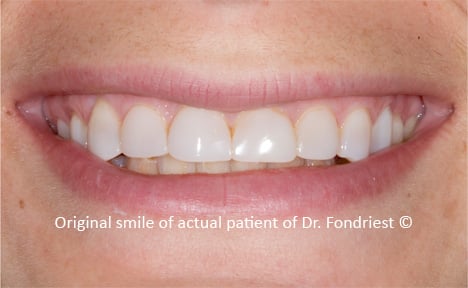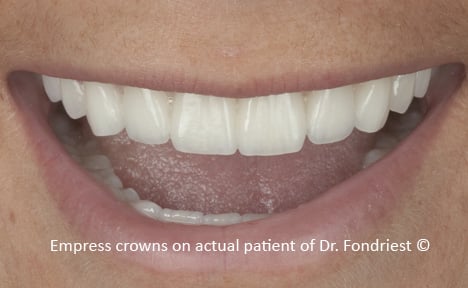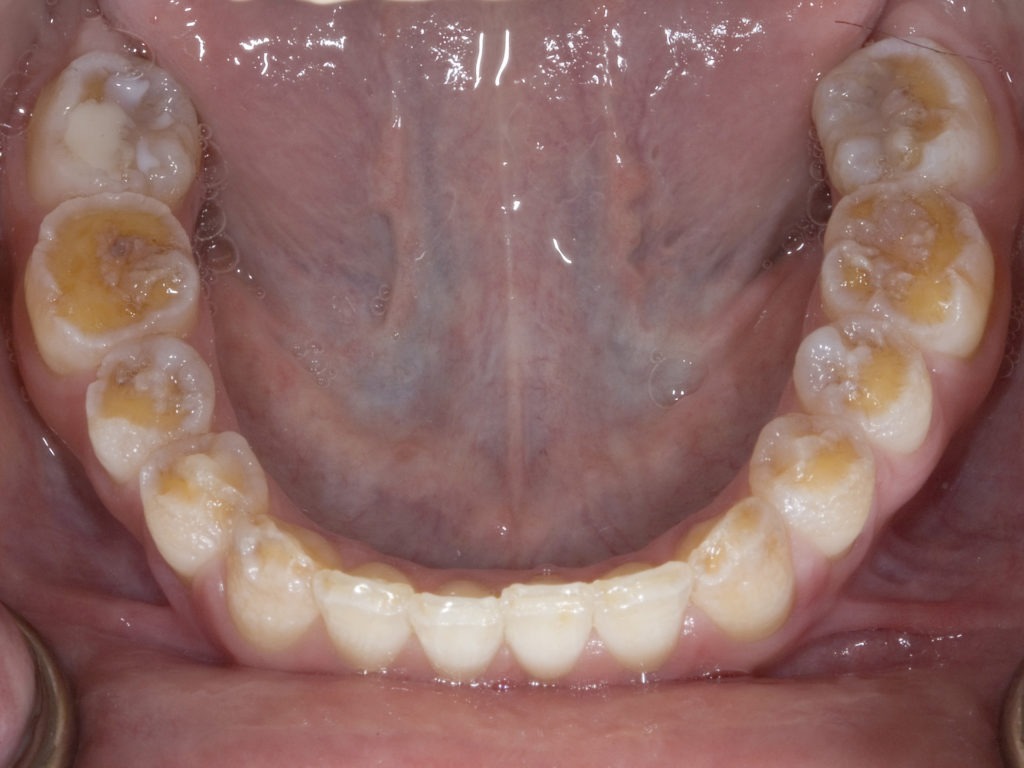
Gluten Intolerance - Celiac Disease
This patient has Celiac disease, a more extreme type of gluten intolerance. The tooth enamel of all of her teeth failed to develop correctly and was soft and very susceptible to wear and stains. Her teeth had been covered over by her former dentist with composite bonding to make them look better. The bonded composite was leaking and staining around the edges and did not have natural tooth shapes. This patient wanted to have symmetrically shaped, bright white but still translucent teeth.

Dental Treatment for enamel hypoplasia caused by Celiac
Due to the poor bonding characteristics of this patient's enamel, crowns had to be placed on every tooth in her mouth to stop the wear and erosion and to restore a healthy occlusal (bite) relationship. Empress crowns were placed on her front teeth and porcelain fused to gold crowns were placed on her posterior teeth. See the case report of her complete dental story.
Did you know that Celiac disease can cause dental problems? Both the enamel and dentin can be affected. The patient whose pictures you see above and below received a diagnosis of celiac disease at age 13. Her tooth enamel failed to develop correctly and as a result was soft and susceptible to stains and wear. Composite bonding placed by her former dentist to improve the look of her teeth showed signs of staining and failing after 18 months. This was probably a result of her poorly developed enamel and dentin (the soft layer below the enamel).
What is Celiac Disease?

Celiac disease tooth enamel picture The dental problems celiac disease includes improper enamel formation. Sometimes, the enamel can’t be bonded well with the commonly used dental filling material called composite.
Celiac disease is an autoimmune digestive disorder. Those with this condition are unable to tolerate gluten, which is commonly found in rye, barley, and wheat products. If these foods are ingested, an adverse immune response occurs in which the small intestine is damaged. This interferes with absorption of nutrients such as calcium from food into the bloodstream which can lead to malnourishment. Failure to thrive during childhood development is a common indicator of celiac.
Frequent and severe outbreaks of aphthous ulcers or canker sores occur in sufferers of all ages. Those not on a gluten free diet have a greater risk for cancers of the mouth, esophagus, and pharynx. Other common symptoms of celiac disease are weight loss, delayed growth and puberty, iron deficiency anemia, joint problems, and weak and brittle bones that are prone to fracture.
Celiac disease has a genetic component that doesn’t always manifest itself. In other words, some people that have the genes don’t seem to have any symptoms or issues. The condition that can be triggered by events such as pregnancy, childbirth, surgery, severe emotional trauma, or a viral infection. The only treatment for celiac disease is a lifelong gluten free diet.
Dental problems with Celiac Disease
Celiac disease is a condition that affects the digestive system. Patients with Celiac disease may have problems with enamel formation. This disease can cause the improper development of enamel on adult teeth. Delayed dental development in the form of slow eruption of adult teeth is also possible. The enamel defects often cause more cavities in children. When the body cannot absorb and distribute nutrients, such as calcium, teeth do not form properly. Due to poorly formed enamel, they can be weak, small, gaped, or discolored. Dr. James Fondriest, a Chicago cosmetic dentist, understands celiac’s impact on dental health, and he has experience repairing the effects of celiac.
A fairly common oral manifestation of celiac disease is abnormal tooth shape and/or appearance. The teeth can be slightly small, widely spaced, and discolored with hypo calcified enamel. When combined with bruxism, weak and poorly developed enamel can cause significant loss of tooth structure for patients. Bonded composite often will not serve well on functional occlusal surfaces.
Patients with dental enamel defects of the entire secondary dentition should be screened for celiac disease even in the absence of gastrointestinal symptoms. There can also be recurrent aphthous stomatitis. This disease affects one in 100 individuals, and 97% of those affected are undiagnosed.
Reasons Behind Enamel Defects in Celiac Disease | Enamel hypoplasia
The exact reason that kids with Celiac have enamel defects. Research is continuing on three most likely theories. The nutritional deficiencies often occur due to damage to the lining of the small intestine with Celiac. These nutritional issues may indirectly cause weakening of the enamel. Another theory is that it is an auto immune issue. Just as the bodies immune system attacks the lining of the small intestine, it also attacks the developing tooth buds of teeth. the third possibility is a genetic link which is associated with Celiac. It has been shown that relatives of patients diagnosed with Celiac often have similar enamel defects. They can even have these defects without themselves having been diagnosed with the condition.
Celiac Disease and Dry Mouth
Dental problems are compounded when salivary flow is reduced. A dry mouth is a common complaint with celiac. Saliva has a major role in preventing dental caries. If the enamel is weak already, then major dental problems can advance quickly. Interestingly, a major cause of chronic dry mouth—Sjögren’s syndrome—is also weakly linked to celiac disease. Sjögren’s syndrome is another autoimmune condition that can cause the immune system to attack the saliva glands. Saliva controls the growth of bacteria that leads to tooth decay. People with Sjögren’s syndrome are also vulnerable to catastrophic tooth decay and tooth loss.
To learn more about the dental problems associated with celiac disease
If you are an adult with celiac with dental damage, we invite you to contact us. Contact us online or give us a call at 847-234-0517.
Dr. Fondriest is a Nationally recognized and highly sought after cosmetic dentist serving clients from throughout the United States
